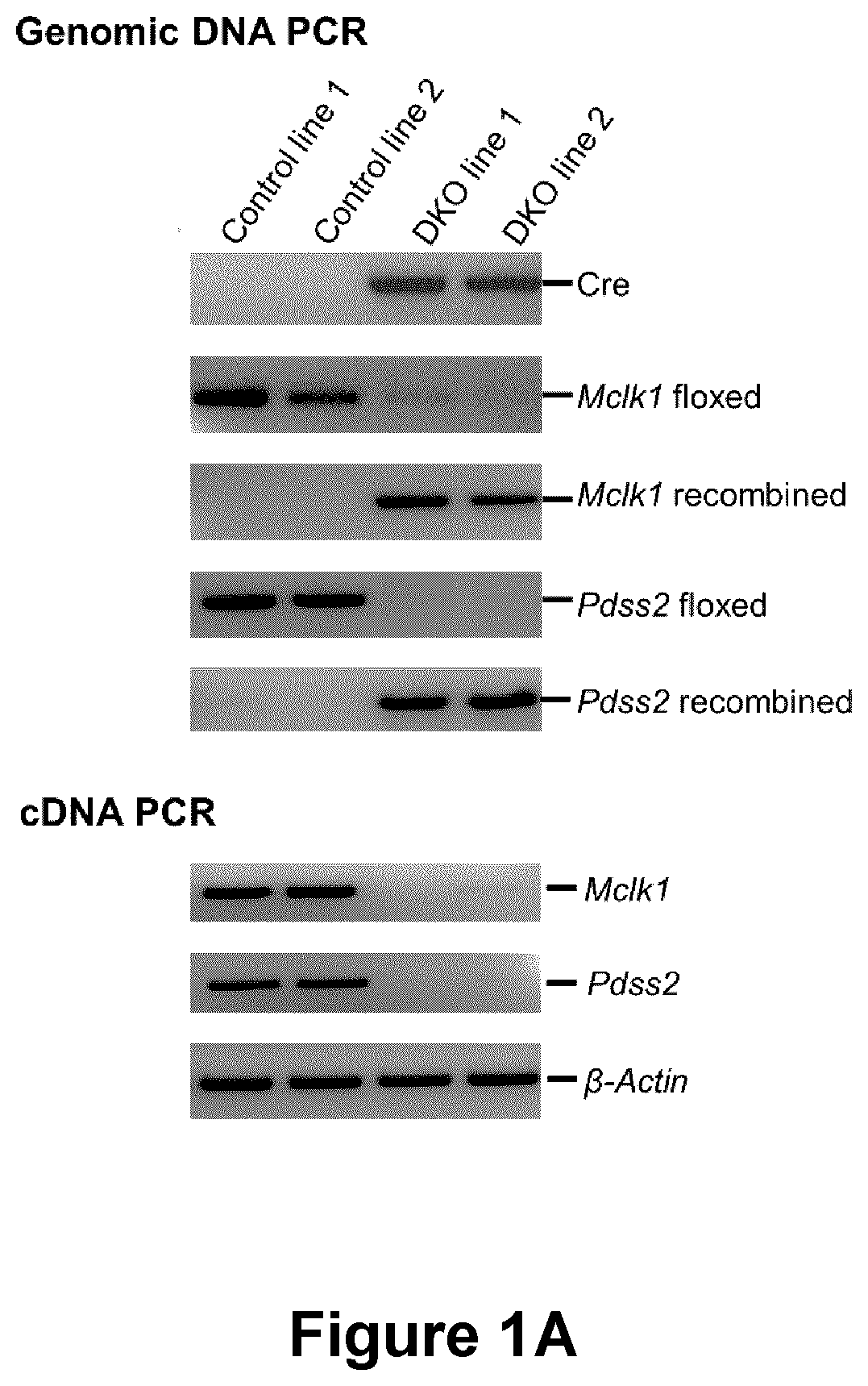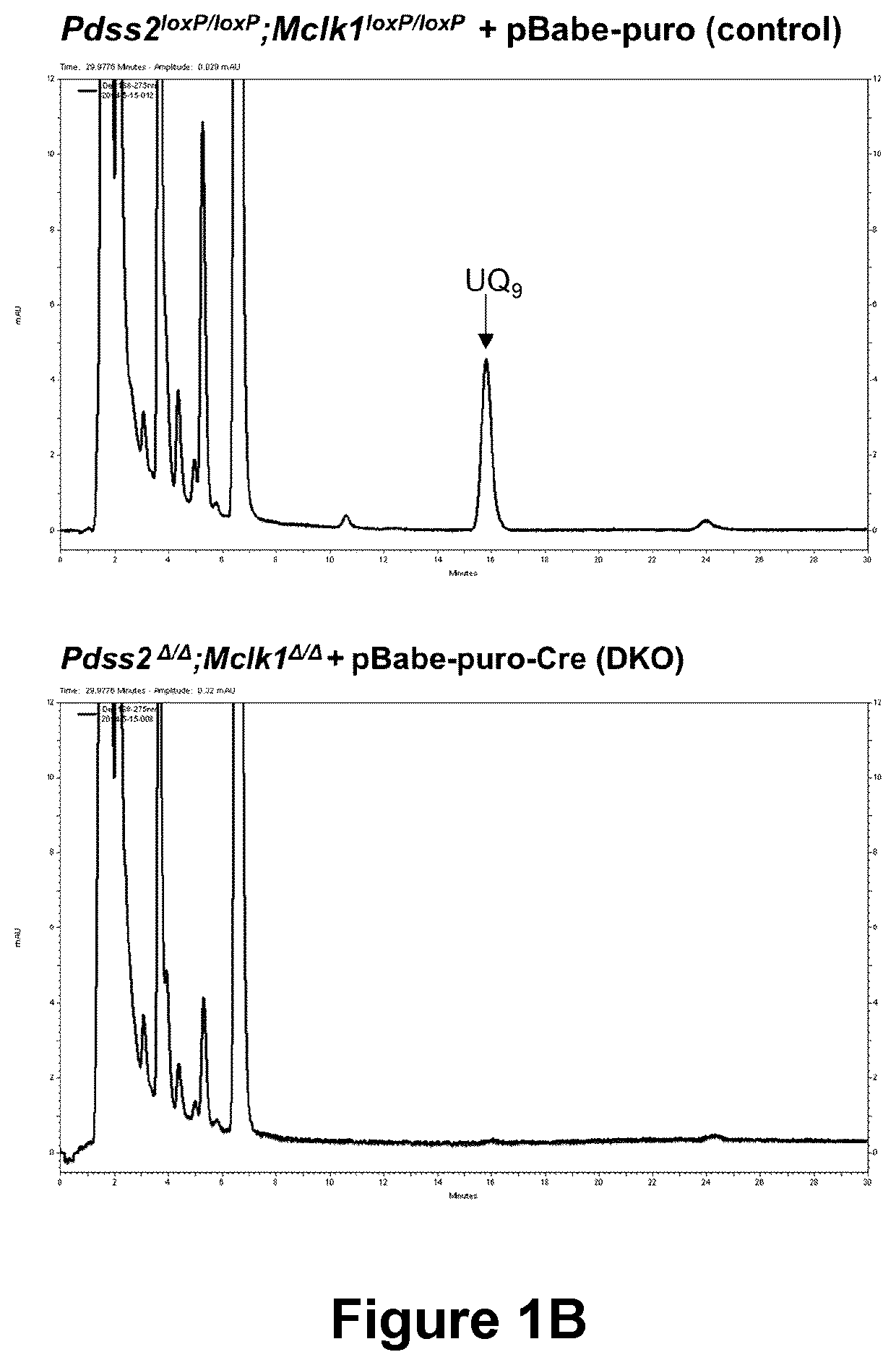Formulations for improving the delivery of hydrophobic agents
a hydrophobic agent and hydrophobic technology, applied in the direction of instruments, inorganic non-active ingredients, antinoxious agents, etc., can solve the problems of limiting the therapeutic utility of hydrophobic agents, and affecting the therapeutic effect of hydrophobic agents, so as to improve the delivery of hydrophobic agents
- Summary
- Abstract
- Description
- Claims
- Application Information
AI Technical Summary
Benefits of technology
Problems solved by technology
Method used
Image
Examples
example i
n and Characterization of UQ-Deficient Cells and Animal Models
[0319]Generation of Pdss2 / Mclk1 double KO (DKO) MEFS. Mice carrying a conditional allele of Mclk1 were crossbred with Pdss2loxP / loxP mice to generate Pdss2 / Mclk1 doubly homozygous conditional knockout mice. The same in vitro Cre / loxP recombination system used for the generation of Mclk1 KO (Wang et al., 2013) was used to generate MEFs deleted for both Pdss2 and Mclk1 genes. Successful inactivation of the conditional (floxed) alleles of Mclk1 or Pdss2 was confirmed by PCR, RT-PCR analyses, and lack of UQ content.
[0320]Tissue culture and viability assays. All cells were maintained in DMEM high glucose medium (Wisent BioProducts, Cat No. 319-005-CL) supplemented with 10% FBS (Thermo Fisher Cat No 10438034) and 1% antibiotic-anti-mycotic solution (Wisent BioProducts, Cat No. 450-115-EL) at 37° C. in 5% CO2. To score growth and viability in galactose, cells were first grown in high glucose DMEM medium to confluency and then sw...
example ii
Screening for Drug Candidates for the Treatment of Ubiquinone Deficiency
[0326]Four different screening methods were developed. The screening methods 1 to 3 are based on rescue-of-lethality in glucose-free galactose-containing media. The presence of galactose instead of glucose forces the cells to rely on oxidative phosphorylation for energy production. Screening method 4 is based on rescue of respiration, implying that processes immediately dependent on UQ have been rescued. Libraries of small molecules were screened for compounds and / or agents that increase survival of UQ-deficient cells (e.g., Mclk1 KO or DKO cells) in standard or modified galactose media depending on the screen settings.
Screening Scheme Galactose-Only Screen
[0327]The screen uses cells lacking UQ (e.g., Mclk1 KO cells) and consists of three key steps:[0328]1) Day 0: preparation of Mclk1 KO cells in 96-well plates in standard (glucose-containing) culture medium.[0329]2) Day 1: changing to glucose-free galactose-con...
example iii
of Properties of Caspofungin in Regards to Ubiquinone Solubilization
[0338]In this present disclosure, caspofungin is sometimes referred to as McC1. FIG. 4 shows the chemical structure of McC1. As it can be seen in FIG. 5, McC1 by itself had no effect on survival of Pdss2 / Mclk1 DKO cells in glucose-free galactose-containing medium. But, in the presence of a minimal amount of UQ10 which on its own was not sufficient to support the survival of Pdss2 / Mclk1 DKO cells, McC1 was able to rescue the mutant cells from death in the respiration-dependent medium. Different concentrations of McC1 were used (10 and 20 μM) and cell viability increased with increasing amount of McC1 in the media (FIG. 5B, last two bars).
[0339]Quantitation of intracellular UQ levels confirms the enhancing effect of McC1 on cellular uptake of UQ10. The results, presented in FIGS. 7A to 7D, show that, when used alone, McC1 had no effect on the intracellular concentration of UQ. However, in combination with UQ10, McC1 i...
PUM
| Property | Measurement | Unit |
|---|---|---|
| solubility | aaaaa | aaaaa |
| solubility | aaaaa | aaaaa |
| solubility | aaaaa | aaaaa |
Abstract
Description
Claims
Application Information
 Login to View More
Login to View More - R&D
- Intellectual Property
- Life Sciences
- Materials
- Tech Scout
- Unparalleled Data Quality
- Higher Quality Content
- 60% Fewer Hallucinations
Browse by: Latest US Patents, China's latest patents, Technical Efficacy Thesaurus, Application Domain, Technology Topic, Popular Technical Reports.
© 2025 PatSnap. All rights reserved.Legal|Privacy policy|Modern Slavery Act Transparency Statement|Sitemap|About US| Contact US: help@patsnap.com



